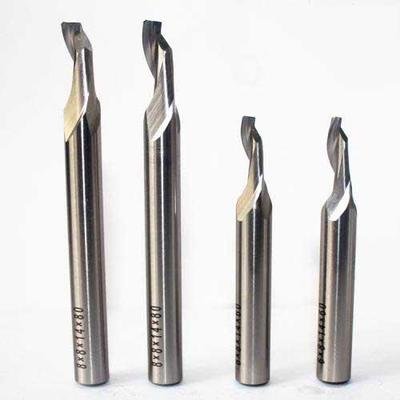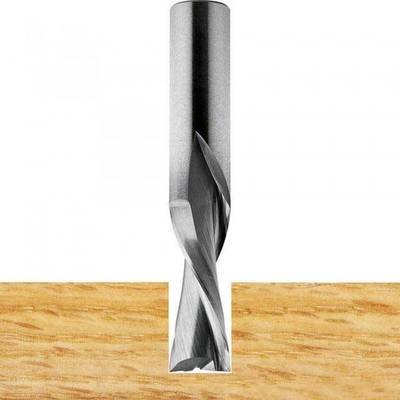Improving the grain size of carbide woodworking tools
By refining the grain size of the hard phase, increasing the surface area between grains, and enhancing the bonding force between grains, the strength and wear resistance of carbide?tool materials can be improved. When the WC grain size is reduced to below submicron size, the hardness, toughness, strength, and wear resistance of the material can be improved, and the temperature required for complete densification can also be reduced. The grain size of ordinary carbides is about 3-5 μm, while that of fine-grained carbides is 1-1.5 μm, and that of ultra-fine-grained carbides can be below 0.5 μm. Compared with ordinary carbides with the same composition, the hardness of ultra-fine-grained carbides can be increased by more than 2 HRA, and the bending strength can be increased by 600-800 MPa.
carbides based on ultra-fine WC grains as the matrix, combined with TiAlN PVD coating, can make the cutting edge of the tool highly ductile during interrupted cutting, while also having extremely strong resistance to thermal deformation.
Surface, overall and cyclic heat treatment for carbide woodworking tools
Surface treatment such as nitriding and boriding can effectively improve the wear resistance of carbide?with good toughness. Overall heat treatment can change the composition and structure of the binding phase in carbide?with good wear resistance but poor toughness, reduce the adjacency of WC hard phase, and thus improve the strength and toughness of carbide. The cyclic heat treatment process can relieve or eliminate the stress between grain boundaries, which can comprehensively improve the performance of carbide?materials.
Improving cutting performance by adding rare metals Adding rare metal carbides such as TaC and NbC to carbide?materials can form a complex solid solution structure with the existing hard phase WC, further strengthen the hard phase structure, and also suppress the growth of hard phase grains and enhance the uniformity of the structure. This is highly beneficial for improving the overall performance of carbide. In the ISO standard P, K, and M carbide?grades, there are carbides added with Ta (Nb) C.

Adding rare earth elements to carbide material
Adding a small amount of rare earth elements such as yttrium to carbide materials can effectively improve the toughness and bending strength of the material, and also improve the wear resistance. This is because rare earth elements can strengthen the hard and binding phases, purify grain boundaries, and improve the wetting of carbide solid solution on the binding phase. carbides added with rare earth elements are most suitable for rough machining, and with abundant rare earth resources in China, they have broad prospects for application in the production of carbide woodworking tools.
Coated carbide woodworking tools
A thin layer of wear-resistant metal compounds, such as TiN and TiC, can be deposited on a tough carbide?substrate using methods such as CVD (chemical vapor deposition), PVD (physical vapor deposition), PVCD (plasma-enhanced chemical vapor deposition), and HVOF (high-velocity oxy-fuel spraying). TiC has high hardness (HV3200) and good wear resistance, so the coating thickness is generally 5-7μm. TiN has lower hardness (HV1800~2100) and lower adhesion to the substrate, but it has good thermal conductivity and high toughness. The coating thickness can reach 8-12μm, and it can combine the toughness of the substrate with the wear resistance of the coating, thereby improving the overall performance of the carbide?tool. Coated carbide?tools have the following advantages:
- Good wear resistance and heat resistance, especially suitable for high-speed cutting;
- Coated carbidetools have strong resistance to chipping and notch wear, and the tool shape and groove shape are stable;
- The chip breaking effect and other cutting performance are good, which is beneficial to the automatic control of the machining process.
- After passivation and refining treatment, the substrate of coated carbide tools has high dimensional accuracy, which can meet the requirements of automatic machining for tool change positioning accuracy. However, the use of coating methods still cannot fundamentally solve the problem of poor toughness and impact resistance of carbide substrate materials.
Nanocoating
Nanocoating is a rapidly developing new coating technology in recent years. The grain size of the coating material is generally below 100 nm and it has good cutting performance. In the coating, the surface smoothness of the coating is improved by grain refinement technology, so that the coating surface is smooth, which can improve the anti-friction and anti-adhesion ability of the coating tool. A CVD coating composed of nanoscale TiCN with inhibited crystal growth and nanoscale Al2O3 with inhibited crystal growth can be selected for the front cutting surface. The coating has extremely high toughness and wear resistance. Applying ultra-fine grain TiCN on a special carbide substrate improves the adhesion between the coating and the substrate. Then, an ultra-fine and super smooth FF aluminum-based film is coated on top of it, which increases the surface hardness by 30% and reduces the roughness value by 50%. Compared with ordinary carbides, nanocoating improves processing efficiency by 1.5 times and extends the life of carbide woodworking tools by more than 2 times.

Diamond Coatings
Coating the front surface of a carbide?insert with a CVD diamond film (20μm thick) is a good choice. Although coating peeling can become a serious problem, as long as the coating does not peel, tool wear can be ignored and maintained at 40-50μm. The milling test of medium-density fiberboard using a diamond-coated carbide?insert shows that the diamond film has different degrees of peeling, but the unpeeled film always provides good protection. The tool wear resistance of the diamond coating is nearly twice as high as that of the uncoated one.
With the improvement of coating technology and equipment, the adhesion between the diamond film and the tool substrate will be further improved, and the problem of film peeling will be improved. At present, diamond-coated carbide?materials have been used to manufacture tools for processing reinforced flooring, which is used to cut the aluminum oxide wear-resistant layer on the surface of the reinforced flooring, and the effect is good. However, the purity of CVD diamond polycrystalline film is very high, its hardness (HV9000~1000) is close to natural diamond, and its processability is poor. It is difficult to achieve conventional mechanical processing or electrochemical corrosion. Therefore, diamond-coated carbide?materials are suitable for manufacturing insert blades that do not require regrinding.

Вывод
Carbide woodworking tools have become the main variety in the wood processing industry and will continue to occupy an important position in wood cutting for a considerable period in the future. With the continuous improvement of various carbide performance improvement technologies and coating technologies, the cutting performance of carbide woodworking tools will continue to improve.








